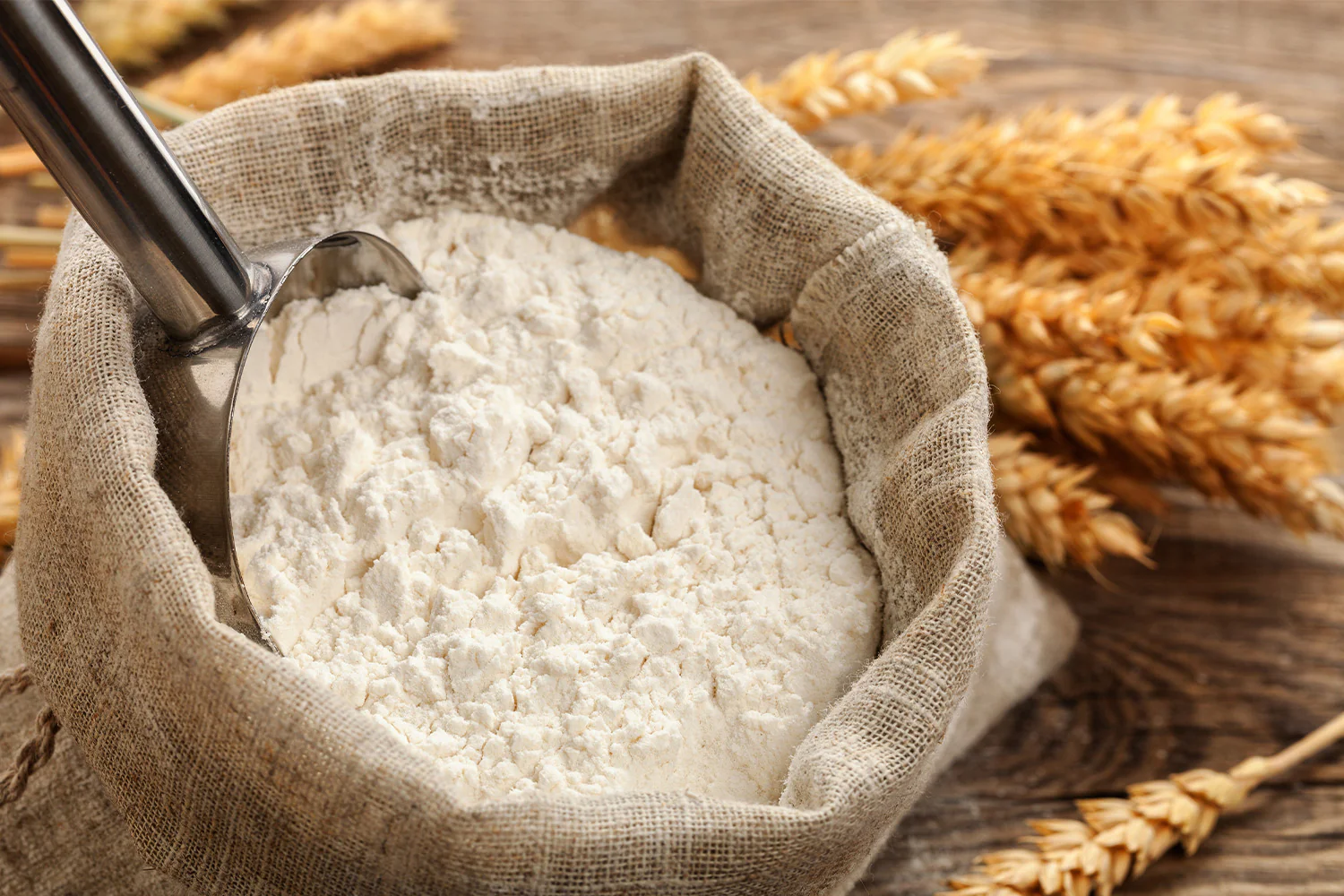Your cart is currently empty!
Benefits and Side Effects of Whole Wheat Flour You Didn’t Know Before

Whole wheat flour has been a staple in Asian households for generations. No matter where you live, whether in the US, the UK, or India, you are sure to find wheat flour on the shelves of the supermarket. It’s been associated with good health due to its active content of minerals, fiber, vitamins, and other nutrients.
However, in the last few years, people have become increasingly concerned about consuming wheat due to wheat allergies, celiac disease, and other health issues. Yet, so far, you have only heard the benefits of whole wheat flour, but it’s important to recognize that it can also have some side effects, making it less ideal for everyone.
This balanced perspective will help you make more informed decisions for your daily diet. As we move forward, we will explore both the advantages and potential drawbacks of adding whole wheat flour to your meals. This way, you can decide what’s best for your health needs. So, let’s get started!
Nutritional Value of Whole Wheat Flour
This table demonstrates the nutrient content and value of whole wheat flour per 100 grams:
| Nutrient | Amount | Daily Value (%) |
| Calories | 340 kcal | 17% |
| Carbohydrates | 72 g | 24% |
| Dietary Fiber | 12 g | 48% |
| Protein | 13 g | 26% |
| Fat | 2 g | 3% |
| Calcium | 33 mg | 3% |
| Iron | 3.6 mg | 20% |
| Magnesium | 138 mg | 34% |
| Phosphorus | 357 mg | 51% |
| Potassium | 405 mg | 12% |
| Zinc | 2.9 mg | 26% |
| Vitamin B6 | 0.3 mg | 15% |
| Folate | 43 mcg | 11% |
Health Benefits of Whole Wheat Flour
Whole wheat flour is made from whole wheat grains that are ground into a fine powder. Unlike white flour, which only uses part of the grain, whole wheat flour includes the bran, germ, and endosperm. This means it keeps more of its natural nutrients, making it a healthier choice.
Let’s look at some of the key health benefits of whole wheat flour.
1. Rich in Nutrients
Whole wheat flour is full of important nutrients. It has vitamins, minerals, and fiber that are good for your body. Some of the key nutrients in whole wheat flour include:
- Fiber: Aids in keeping your digestive system healthy and can prevent constipation.
- Iron: It is important for making red blood cells that carry oxygen around your body.
- Magnesium: Helps your nerves and muscles work properly and keeps your bones strong.
- B vitamins: Help turn the food you eat into energy.
2. Good for Digestion
The fiber in whole wheat flour is especially good for your digestion. Fiber helps your stool pass through your intestines more easily. This can prevent problems like constipation.
Eating enough fiber can also reduce the risk of developing digestive issues like diverticulosis, which is when small pouches form in your intestines and get inflamed.
3. Helps Control Blood Sugar Levels
Whole wheat flour has a comparatively lower glycemic index than white flour. This means it doesn’t raise your blood sugar levels quickly.

For people with diabetes or those trying to prevent it, eating foods made with whole wheat flour can help keep blood sugar levels stable. This is because the fiber in whole wheat flour slows down the process of sugar absorption into the bloodstream.
4. Supports Heart Health
Eating whole wheat flour can be good for your heart. The fiber, vitamins, and minerals found in whole wheat flour can help reduce the risk of heart disease.
Fiber aids in lowering bad cholesterol levels by binding to cholesterol in your digestive system and carrying it out of your body. Additionally, the magnesium in whole wheat flour can help regulate blood pressure, further supporting heart health.
5. Helps with Weight Management
Whole wheat flour can help with weight management. Foods made with whole wheat flour are more filling compared to those made with white flour. This is because the fiber in whole wheat flour takes longer to digest, which helps you feel full for longer.
Eating whole wheat foods can help you feel full for long and avoid overeating, making it easier to maintain a healthy weight.
6. Provides Long-Lasting Energy
Whole wheat flour provides long-lasting energy because it contains complex carbohydrates. These types of carbohydrates break down slowly compared to simple carbohydrates found in sugary foods.
This slow release of energy helps keep you feeling energetic and alert throughout the day without random spikes in blood sugar levels.
7. Supports Healthy Skin
Whole wheat flour contains vitamins and minerals that support healthy skin. For example, vitamin E is an anti-oxidant that aids skin protection from damage caused by free radicals. Zinc, another mineral found in whole wheat flour, helps your skin heal and can prevent acne.
8. Reduced Risk of Certain Cancers
Some studies have suggested that eating whole grains, like whole wheat flour, leads to reduced risk of certain cancers. The fiber, antioxidants, and other nutrients in whole wheat flour can help protect your cells from damage that can lead to cancer. More research is needed to understand the full impact, but including whole wheat flour in your diet is a good step toward better health.
Potential Side Effects of Whole Wheat Flour
Whole wheat flour is filled with nutritional benefits. But, like many foods, it can also have some side effects. Let’s look at the possible downsides of eating whole wheat flour in simple terms.
1. Digestive Problems
Some people have trouble digesting wheat. This is especially true for those with gluten sensitivity or celiac disease. Gluten is a protein found in wheat. For those sensitive to gluten, eating whole wheat flour can cause stomach pain, bloating, and diarrhea.
2. Allergic Reactions
Wheat allergies are another concern. People with a wheat allergy might experience symptoms like itching, rashes, and swelling. In severe cases, it may lead to conditions like anaphylaxis, a serious allergic reaction that needs immediate medical attention.
3. High Glycemic Index
While whole wheat flour has a comparatively lower glycemic index compared to some white flour, but it still has higher GI levels. This means it can boost blood sugar levels quickly. For people with diabetes, this can be a problem. It’s important to regularly monitor your health, especially blood sugar levels to avoid complications.
4. Phytic Acid
Whole wheat flour contains phytic acid. It can bind to minerals in the food you eat, making it so hard for your body to absorb them. This can lead to severe mineral deficiencies over time. Phytic acid is sometimes called an “anti-nutrient” because of this effect.
5. Weight Gain
Whole wheat flour is high in carbohydrates. Consuming too much carbs can lead to weight gain if you don’t balance it with physical activity. It’s important to eat whole wheat flour in moderation as part of a balanced diet.
6. Irritable Bowel Syndrome (IBS)
People with IBS might find that eating whole wheat flour makes their symptoms worse. This is because wheat can be hard to digest and might irritate the digestive system. Symptoms of IBS include stomach pain, bloating, and changes in bowel habits.
7. Skin Problems
In some cases, eating whole wheat flour can cause skin problems. This is usually due to an allergic reaction or gluten sensitivity. Symptoms can include itching, rashes, and even eczema.
Conclusion
Whole wheat flour is always the top staple on the Indian grocery list. It’s part of everyday meals for Asian households, especially Indians. As we discussed above, there are a lot of benefits to adding whole wheat flour to your daily diet. However, it has been associated with some severe allergies.
Whether whole wheat atta is healthy or not, has long been a topic of discussion, with some dieticians recommending adding it to your daily diets. Meanwhile, some experts emphasize using its substitutes like quinoa flour, almond flour, oats flour, buckwheat flour, sorghum flour, and millet flour.
No matter what type of flour you gonna use in your kitchen, you are sure to find them on GroceryRoute. So, save time and money standing in long queues in supermarkets, order hasslefree on GroceryRoute, and get your groceries delivered to your home.
FAQs
Is Whole Wheat Flour Atta or Maida?
Whole wheat flour is commonly referred to as “atta.” It is made from grinding the entire wheat grain, which includes the bran, germ, and endosperm. In contrast, “maida” is a highly refined flour made from the endosperm only, resulting in a finer texture and whiter color. Atta retains more nutrients compared to maida.
Is Whole Wheat Flour Actually Healthy?
Yes, whole wheat flour is generally considered healthy. It contains vitamins, dietary fiber, and minerals, which are essential for good health. Fiber aids in digestion, while vitamins and minerals support various bodily functions.
What is the Difference Between Flour and Whole Wheat Flour?
The main difference between regular flour (often called all-purpose flour) and whole wheat flour is the processing. Whole wheat flour includes the entire wheat grain—bran, germ, and endosperm. This makes it more nutritious and higher in fiber. Regular flour is more refined, typically made from the endosperm alone, resulting in a finer texture but fewer nutrients.
Is It OK to Eat Wheat Flour Everyday?
For most people, it’s okay to eat wheat flour every day as part of a balanced diet. Whole wheat flour provides essential nutrients and fiber. However, individuals with gluten sensitivity, celiac disease, or wheat allergies should avoid it. As with any food, moderation is key to avoiding excessive carbohydrate intake and maintaining overall health.
What is a Replacement for Whole Wheat Flour?
There are several replacements for whole wheat flour, depending on dietary needs. Some common alternatives include Almond Flour, Oat Flour, and Rice Flour.
Leave a Reply